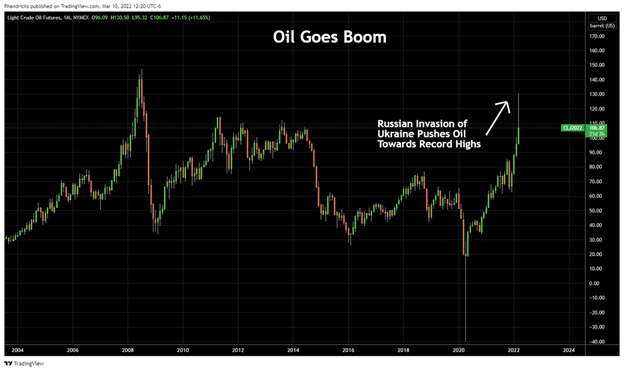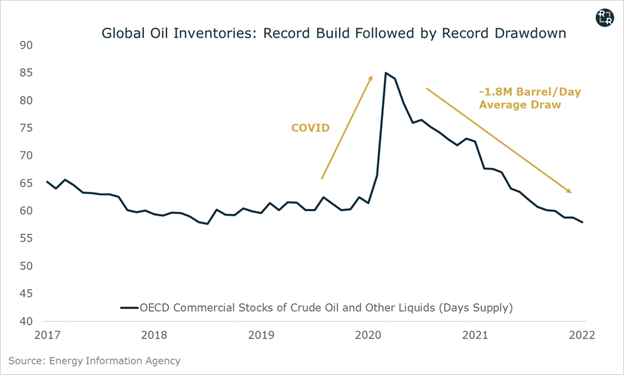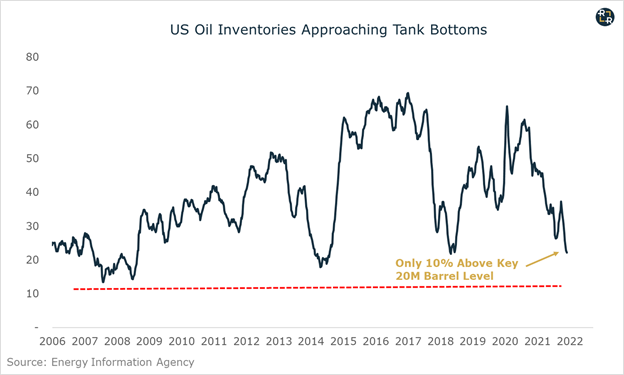Vladimir Putin's invasion of Ukraine threw a spark into the powder keg of the global oil market. The incursion sent oil prices barreling towards new record highs. And without a relatively quick resolution, we could see even more explosive gains ahead: 
While the geopolitical situation is complex, and prices for now have retreated somewhat, the impact of war and other global disruptions on oil markets impact distills down to basic supply and demand. Even before the Ukraine conflict, the world was running short of oil, signaled by prices rallying above $90 per barrel at the start of 2022.
Now, the market risks losing millions of barrels of supply at the worst possible time.
Below, I’ll explain why a prolonged disruption of Russian exports could make today’s prices for both WTI and Brent—which continue to hover around the $100 level—seem cheap. Absent a quick resolution, we could face the prospect of $200 per barrel, or even higher.
Unprecedented Supply Disruption
Russia is the world’s third largest oil producer, with output of 11.3 million barrels per day (bbl/d). The country consumes about 3.5 million of those barrels domestically, while exporting more than 7 million bbl/d of crude oil and refined products daily (the term “oil” will refer to both crude and refined products in this article). That makes Russia the world’s single largest oil exporter.
Before the Russian invasion of Ukraine, 4.8 million bbl/d of Russian oil exports went to countries that are now backing sanctions against Russia. This primarily includes western European countries that are part of the EU, plus the U.S. and a few others. Meanwhile, another 2.3 million bbl/d goes to countries not backing sanctions—primarily China, along with several eastern European countries (here's who buys Russian oil exports).
While we can likely count on China and Eastern Europe to continue buying Russian oil, that still leaves a massive 4.8 million bbl/d of exports at risk from the escalating tensions between Russia and the West.
Outside of coordinated OPEC actions—which typically occur in bear markets—the world has never before suffered a supply disruption of this magnitude. Of course, Western leaders appreciated the critical nature of Russian exports in balancing the global oil market. That’s why the politicians initially avoided direct sanctions on Russian energy in the wake of the invasion.
However, the scope of the financial sanctions leveled against Russia were the most sweeping of any kind ever implemented. So despite these intentions, the Russian oil trade got caught in the crossfire as collateral damage.
Caught in the Sanctions Crossfire
Physical oil trading is a complex business that involves multiple layers of transactions and counterparties. So even where Russian crude is still technically legal to trade, the sanctions package in many cases has gummed up the inner-workings of the trade to the point of killing the market.
One example: physical oil traders often use letters of bank credit to finance the purchase of crude oil cargoes. But as the Wall Street Journal reports:
“[The] banks that grease the wheels of international commerce are refusing to finance Russian commodity deals.”
Without this critical source of financing, traders can’t buy Russian crude and deliver it into the global market. Meanwhile, we’re hearing similar reports of refiners, insurance providers and other key cogs in the physical market stepping away from dealing in Russian oil. Even if the transactions aren’t technically illegal, these players simply don’t want the risk or headache involved.
As one trader at a major commodities broker simply explained: “the market is starting to fail.”
Meanwhile, even if Western companies are willing to take the legal/financial risk of buying Russian crude, they now face huge reputational risk. Case in point, oil supermajor Shell (NYSE:SHEL) purchased 100,000 barrels of Russian crude at a record discount a week ago Friday. The backlash was enough to spark a public apology from Shell last Tuesday, along with a commitment to “stop all spot purchases of Russian crude oil.”
The situation escalated further last week, when the Biden administration took direct aim at Russian energy by announcing a ban on Russian oil imports into the U.S. The U.K. followed up with a similar ban on imports of Russian crude.
Russia quickly responded with the prospect of banning Russian commodity exports in response to Western sanctions.
So already, a substantial portion of the 4.8 million bbl/d of Russian oil exports to Western economies is disrupted by the indirect impact of sanctions and popular pressure. Now, escalating tensions threaten to directly impair the entire 4.8 million bbl/d of export volumes.
This would be a massive disruption during normal times. It’s an even bigger problem for today’s oil market, which was already facing a major supply deficit even before the threat of losing millions of Russian barrels.
Global Oil Inventories Running on Fumes
During the initial COVID-19 outbreak, economic shutdowns around the globe briefly took up to 20 million bbl/d of demand offline. This created a historic build in crude inventories. However, the market quickly flipped from surplus to deficit as supply came offline and demand rebounded. By Q3 2020, the market entered into a structural deficit, with global crude inventories drawing down by an average of 1.8 million barrels per day (bbl/d) through Q4 2021: 
On the surface, a 1.8 million bbl/d deficit might seem modest in the context of a 90–100 million bbl/d global market. But this shows why the price of oil (and all other commodities) is set by the marginal barrel. It only took a roughly 2% daily supply deficit, compounded over 18 months, to erase a record oil surplus in record time.
So, you can imagine the catastrophic impact of a 5% supply deficit from the disruption in Russian oil exports. Especially given the current backdrop of oil inventories approaching the low end of their historical range.
On that note, today’s inventory situation could be even worse than pictured above. Let me explain…
You see, the big public forecasting agencies that report on global oil stockpiles aren’t measuring tank levels. Instead, they estimate supply and demand, and take the net result as an implied inventory change. That means a faulty read on either supply or demand could produce a faulty inventory estimate. And it turns out, that’s exactly what’s happened in recent years.
200 Million Missing Oil Barrels
The International Energy Agency (IEA) is a key source for information on global oil supply and demand. So it raised more than a few alarm bells when the IEA recently admitted to massively underestimating global oil demand in recent years. After revising up their demand figures, the agency reported that global oil stockpiles are about 200 million barrels lighter than previously expected.
That means today’s global oil market could actually be much tighter than the numbers reported by agencies like the IEA.
For a more accurate measure of inventories, we can look at the weekly storage levels in Cushing, Oklahoma—the key hub that sets the WTI oil price. Unlike the global inventory data that comes from supply/demand guesses, the storage tanks at Cushing are directly measured each week.
The latest data shows that Cushing stocks have fallen to just 22.2 million barrels. That’s only about 10% above the operational minimum level of ~20 million barrels, and moving lower with each passing week:
The bottom line: today’s oil market has very little margin of error.
On Wednesday, I'll analyze the supply and demand trends that got us here, which will then provide a roadmap for what we might expect from oil markets going forward.
Editor's Note: this content was originally posted at the Ross Report.
